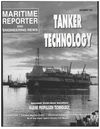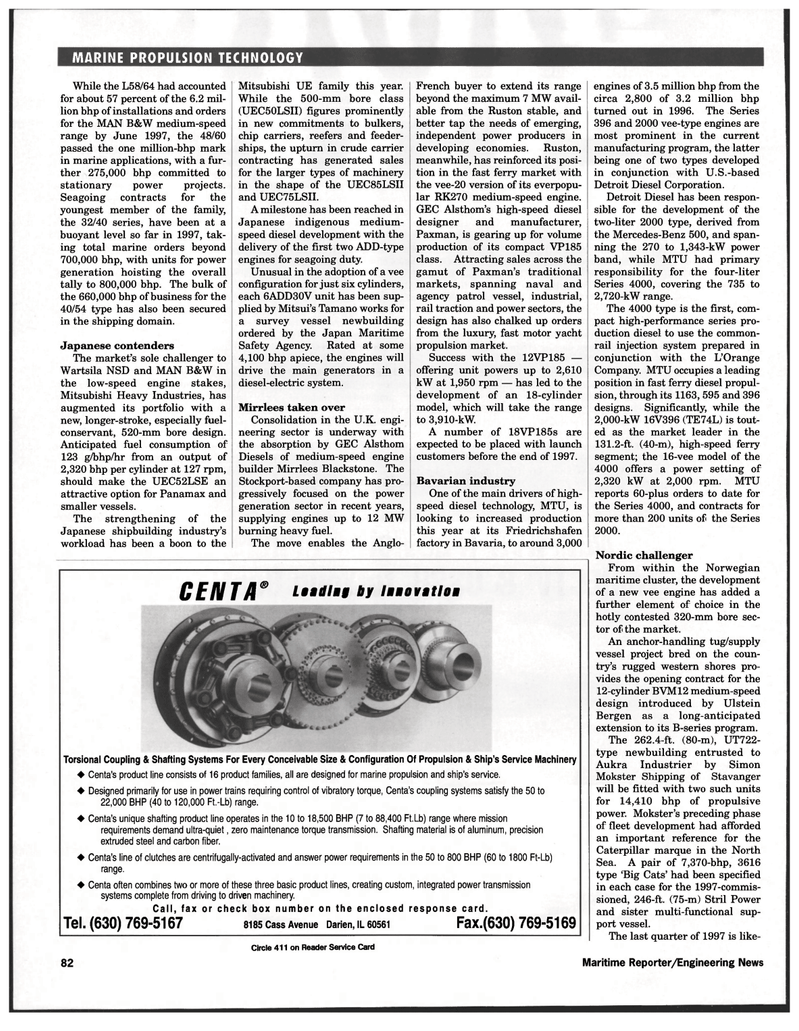
Page 82: of Maritime Reporter Magazine (September 1997)
Read this page in Pdf, Flash or Html5 edition of September 1997 Maritime Reporter Magazine
MARINE PROPULSION TECHNOLOGY
While the L58/64 had accounted for about 57 percent of the 6.2 mil- lion bhp of installations and orders for the MAN B&W medium-speed range by June 1997, the 48/60 passed the one million-bhp mark in marine applications, with a fur- ther 275,000 bhp committed to stationary power projects.
Seagoing contracts for the youngest member of the family, the 32/40 series, have been at a buoyant level so far in 1997, tak- ing total marine orders beyond 700,000 bhp, with units for power generation hoisting the overall tally to 800,000 bhp. The bulk of the 660,000 bhp of business for the 40/54 type has also been secured in the shipping domain.
Japanese contenders
The market's sole challenger to
Wartsila NSD and MAN B&W in the low-speed engine stakes,
Mitsubishi Heavy Industries, has augmented its portfolio with a new, longer-stroke, especially fuel- conservant, 520-mm bore design.
Anticipated fuel consumption of 123 g/bhp/hr from an output of 2,320 bhp per cylinder at 127 rpm, should make the UEC52LSE an attractive option for Panamax and smaller vessels.
The strengthening of the
Japanese shipbuilding industry's workload has been a boon to the
Mitsubishi UE family this year.
While the 500-mm bore class (UEC50LSII) figures prominently in new commitments to bulkers, chip carriers, reefers and feeder- ships, the upturn in crude carrier contracting has generated sales for the larger types of machinery in the shape of the UEC85LSII and UEC75LSII.
A milestone has been reached in
Japanese indigenous medium- speed diesel development with the delivery of the first two ADD-type engines for seagoing duty.
Unusual in the adoption of a vee configuration for just six cylinders, each 6ADD30V unit has been sup- plied by Mitsui's Tamano works for a survey vessel newbuilding ordered by the Japan Maritime
Safety Agency. Rated at some 4,100 bhp apiece, the engines will drive the main generators in a diesel-electric system.
Mirrlees taken over
Consolidation in the U.K. engi- neering sector is underway with the absorption by GEC Alsthom
Diesels of medium-speed engine builder Mirrlees Blackstone. The
Stockport-based company has pro- gressively focused on the power generation sector in recent years, supplying engines up to 12 MW burning heavy fuel.
The move enables the Anglo-
French buyer to extend its range beyond the maximum 7 MW avail- able from the Ruston stable, and better tap the needs of emerging, independent power producers in developing economies. Ruston, meanwhile, has reinforced its posi- tion in the fast ferry market with the vee-20 version of its everpopu- lar RK270 medium-speed engine.
GEC Alsthom's high-speed diesel designer and manufacturer,
Paxman, is gearing up for volume production of its compact VP185 class. Attracting sales across the gamut of Paxman's traditional markets, spanning naval and agency patrol vessel, industrial, rail traction and power sectors, the design has also chalked up orders from the luxury, fast motor yacht propulsion market.
Success with the 12VP185 — offering unit powers up to 2,610 kW at 1,950 rpm — has led to the development of an 18-cylinder model, which will take the range to 3,910-kW.
A number of 18VP185s are expected to be placed with launch customers before the end of 1997.
Bavarian industry
One of the main drivers of high- speed diesel technology, MTU, is looking to increased production this year at its Friedrichshafen factory in Bavaria, to around 3,000 engines of 3.5 million bhp from the circa 2,800 of 3.2 million bhp turned out in 1996. The Series 396 and 2000 vee-type engines are most prominent in the current manufacturing program, the latter being one of two types developed in conjunction with U.S.-based
Detroit Diesel Corporation.
Detroit Diesel has been respon- sible for the development of the two-liter 2000 type, derived from the Mercedes-Benz 500, and span- ning the 270 to 1,343-kW power band, while MTU had primary responsibility for the four-liter
Series 4000, covering the 735 to 2,720-kW range.
The 4000 type is the first, com- pact high-performance series pro- duction diesel to use the common- rail injection system prepared in conjunction with the L'Orange
Company. MTU occupies a leading position in fast ferry diesel propul- sion, through its 1163, 595 and 396 designs. Significantly, while the 2,000-kW 16V396 (TE74L) is tout- ed as the market leader in the 131.2-ft. (40-m), high-speed ferry segment; the 16-vee model of the 4000 offers a power setting of 2,320 kW at 2,000 rpm. MTU reports 60-plus orders to date for the Series 4000, and contracts for more than 200 units of the Series 2000.
Nordic challenger
From within the Norwegian maritime cluster, the development of a new vee engine has added a further element of choice in the hotly contested 320-mm bore sec- tor of the market.
An anchor-handling tug/supply vessel project bred on the coun- try's rugged western shores pro- vides the opening contract for the 12-cylinder BVM12 medium-speed design introduced by Ulstein
Bergen as a long-anticipated extension to its B-series program.
The 262.4-ft. (80-m), UT722- type newbuilding entrusted to
Aukra Industrier by Simon
Mokster Shipping of Stavanger will be fitted with two such units for 14,410 bhp of propulsive power. Mokster's preceding phase of fleet development had afforded an important reference for the
Caterpillar marque in the North
Sea. A pair of 7,370-bhp, 3616 type 'Big Cats' had been specified in each case for the 1997-commis- sioned, 246-ft. (75-m) Stril Power and sister multi-functional sup- port vessel.
The last quarter of 1997 is like-
CENTA® Leaning by Innovation
Torsional Coupling & Shafting Systems For Every Conceivable Size & Configuration Of Propulsion & Ship's Service Machinery • Centa's product line consists ot 16 product families, all are designed for marine propulsion and ship's service. • Designed primarily for use in power trains requiring control of vibratory torque, Centa's coupling systems satisfy the 50 to 22,000 BHP (40 to 120,000 Ft.-Lb) range. • Centa's unique shafting product line operates in the 10 to 18,500 BHP (7 to 88,400 Ft.Lb) range where mission requirements demand ultra-quiet, zero maintenance torque transmission. Shafting material is of aluminum, precision extruded steel and carbon fiber. • Centa's line of clutches are centrifugally-activated and answer power requirements in the 50 to 800 BHP (60 to 1800 Ft-Lb) range. • Centa often combines two or more of these three basic product lines, creating custom, integrated power transmission systems complete from driving to driven machinery.
Call, fax or check box number on the enclosed response card.
Tel. (630) 769-5167 S1S5 Cass Avenue Darien, IL 60561 FaX.(630) 769-5169
Circle 411 on Reader Service Card 82 Maritime Reporter/Engineering News

 81
81

 83
83
